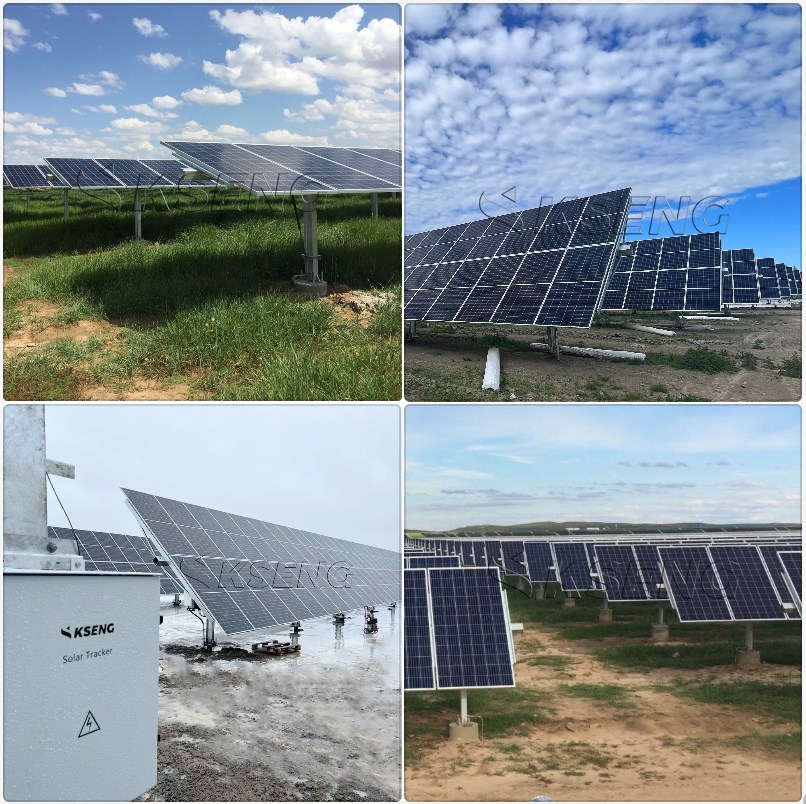Kseng Multi-Drive Dual Portrait Horizontal Single-Axis Solar Tracking System is a highly engineered solar racking solution that combines multiple drive units with a two-row solar panel layout for more accurate solar tracking and higher power generation efficiency.
Brand:
KsengProduct Origin:
ChinaShipping Port:
XiamenMaterial:
carbon steelDrive System:
Slewing DriveTracking Range:
±45°to ±60°Tracking Accuracy:
±1°

KST-2PM adopt 3-4 actuator drive though transfer bar, stable and reliable, become most cost-effective bifacial solution.Kseng`s solar tracking systems adopt the spindle and column with large section specification are adopted to improve the stability and reliability of the system.Paten torque tube fastener,3 times faster installation speed than traditional one. Kseng solar panel mounting bracket is designed with a tracking mechanism that directs the panel towards the area of high sunlight intensity. It also has a method of concentrating the sunlight onto the photo receptors on the solar panel. All of these maximize the amount of solar energy collected from the sun within a specific time frame,thus, increasing the efficiency of the solar panel in absorbing solar energy by at least 15%.



|
Structure Parameters |
|
|
System type |
Multi-drive Double Portrait Horizontal single-axis tracking system |
|
Maximum capacity per row |
72KWp (Estimated with 600W PV -Modules) |
|
PV-Modules quantity per row |
2Px60, 2Px45 |
|
Tracking range |
±60° |
|
Tracking accuracy |
±1° |
|
Materials |
HDG Steel, Al-Mg-Zn Coating
Steel |
|
Foundation |
Concrete foundation, Steel
pile, PHC pile |
|
Quantity of foundation/MW |
125PCS/MW (Estimated with 600W PV-Modules) |
|
Controller Parameters |
|
|
Controller system |
MCU |
|
Tracking method |
Astronomical
algorithm+closed-loop control (AI) |
|
Signal transmission |
Wire (RS485) or wireless (Zig bee) |
|
Drive method |
Linear-actuator |
|
Motor type |
DC 24V |
|
Power supply |
AC-powered or self-powered |
|
Foundation |
Concrete foundation, Steel
pile, PHC pile |
Advanced AI tracking algorithm
AI self-learning algorithm to optimize the angular deviation caused by terrain and bracket installation errors. Compared with the traditional tracking algorithm, the power generation of the power station can be increased by 2%-3%.

Kseng KST-2PM Features
1: Multi-point linear-actuator drive system
2: Suitable for the high wind load areas
3:Fully fit for 210 module
4:Al algorithm to maximize power generation
5:Adapt to various terrains allowing a north-south slope up to 20%
6:Easy installation & maintenance


Terrain adaptability:
1. Flexible arrangement, make full use of irregular land and can improve land utilization.
2. North and South can adapt to 20% slope.
3. Unlimited slope in the east-west.

How does a single axis solar tracker work?
A single-axis solar tracker is a device that adjusts the position of solar panels or photovoltaic modules to maximize their exposure to sunlight throughout the day. Unlike fixed solar panel installations, which remain stationary, single-axis solar trackers follow the sun's path in the sky, improving energy generation and overall efficiency.
Here's how a single-axis solar tracker typically works:
1. Orientation: In the morning, the solar tracking system starts by facing east, perpendicular to the incoming sunlight. This initial position allows for optimal energy production during the morning hours.
2. Movement: As the day progresses, the automatic solar tracking system slowly rotates on a single axis, typically a horizontal one. The tracker mechanism uses sensors or algorithms to calculate the sun's position, determining the direction in which the panels need to move. The rotation allows the panels to continuously face the sun, maximizing the amount of sunlight they receive.
3. Tracking Algorithm: The solar panel tracking control system integrates various sensors and algorithms to determine the sun's location accurately. These sensors often include light sensors or GPS receivers, which provide data to help calculate the optimal position of the panels. Advanced trackers can also take other factors into account, such as weather conditions and seasonal variations, to optimize energy production.
4. Safety Features: single axis solar tracking system commonly incorporate safety features to protect the panels from harsh weather conditions. For example, they may have wind sensors that can detect strong gusts and automatically stow the panels in a safe position to prevent damage.
5. End of Day: In the evening, as the sun sets in the west, the sun tracking solar system aligns the panels to face westward to capture the remaining sunlight. This position helps maximize energy production during the late afternoon and evening.
By continuously adjusting the position of the solar panels to face the sun directly, single-axis solar trackers can capture more solar energy throughout the day and increase the overall electricity output of a solar installation.
Related Tags :